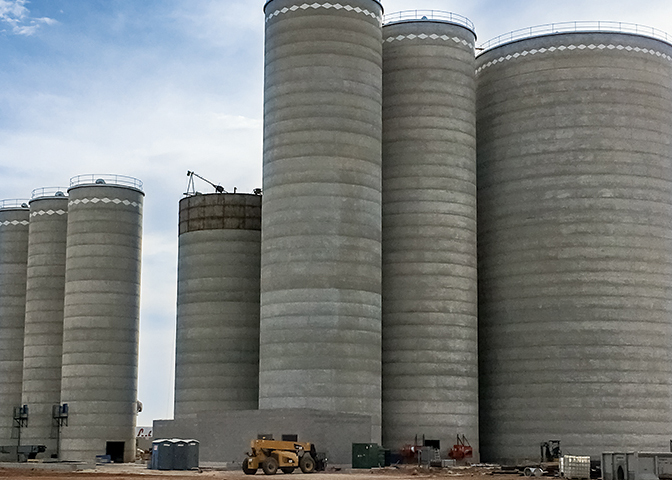Home > Oklahoma > Oklahoma Crops & Livestock > Oklahoma is Right as Grain
Oklahoma is Right as Grain

A new automated grain facility, the Chisholm Trail Terminal, is expected to shuttle Oklahoma wheat deliveries to export markets faster than ever – helping fulfill demand for the commodity across the nation and overseas.
Grain exporters in the U.S. depend on rail and barge transportation to deliver wheat to export markets. Located near Medford, the Chisholm Trail Terminal moves grain in a more efficient way. The terminal is owned by a limited liability company formed by the Farmers Grain Company, Equity Marketing Alliance and CoMark Grain Marketing.
“The real benefit of the terminal is that we will be able to capture those efficiencies in grain margins and return that value to our owners,” says Kent Prickett, CEO of Farmers Grain Company. Prickett is not aware of any other automated grain facilities in the state.
Bins and bunkers at the Chisholm Trail Terminal hold up to 5 million bushels of wheat, which equals more than a dozen 110-car rail loads. The terminal is adjacent to the Union Pacific rail line that runs to the Gulf of Mexico.
“We installed a little over 10,000 feet of loop track from the Union Pacific Line to accommodate train sizes up to 130 cars,” says Farmers Grain’s Montie Walton, who managed project construction.
![OK GRAIN COUNTIES [INFOGRAPHIC]](https://eadn-wc01-4177395.nxedge.io/wp-content/uploads/2020/05/Screen-Shot-2016-07-13-at-1.41.04-PM.jpg) That continuous loop track lets trains move through without splitting up – or breaking – cars, which saves time. Time preservation is vital to meet transport and grain exporter demands. Fast, guaranteed loading times help railroads maximize line usage. Rail operators, such as Union Pacific, provide incentives for shuttle grain terminals to load trains within certain time constraints.
That continuous loop track lets trains move through without splitting up – or breaking – cars, which saves time. Time preservation is vital to meet transport and grain exporter demands. Fast, guaranteed loading times help railroads maximize line usage. Rail operators, such as Union Pacific, provide incentives for shuttle grain terminals to load trains within certain time constraints.
“We’ll be able to load about 400,000 bushels in less than 15 hours,” says Ryan McCoy, president and CEO of CoMark Grain Marketing.
Capturing those incentives results in more favorable transportation costs, and cost savings that could return more profits for the farmer-owners of the cooperatives operating the terminal.
Computers control grain flowing from 210-foot bucket elevators into the storage silos,
as well as grain moving along the main grain conveyor line, more than 130 feet long. Only four people are needed to load out a 110-car shuttle train within 15 hours. Older systems required 12 to 14 people for that job; the shuttle terminal cuts the labor need in half or more. The fully automated facility will create up to eight new jobs for Grant County, Prickett says.
![OK GRAIN [INFOGRAPHIC]](https://eadn-wc01-4177395.nxedge.io/wp-content/uploads/2020/05/Screen-Shot-2016-07-13-at-1.41.10-PM.jpg) Other grains may move through the terminal, but wheat is expected to make up 90 percent of the volume.
Other grains may move through the terminal, but wheat is expected to make up 90 percent of the volume.
“Our cooperative markets a lot of grain from that area. We feel the terminal will bring value to our customers,” McCoy says.
The new terminal is easily accessible.
“The site is in an ideal location near both state and U.S. highways,” Walton says. “It should be a great benefit to the farmers and elevators here.”
Tom McCreight of Equity Marketing Alliance says cooperative members are excited at the prospect of being able to ship wheat more efficiently to Mexico, the second-largest U.S. wheat export market in 2015.
![OK GRAIN [INFOGRAPHIC]](https://eadn-wc01-4177395.nxedge.io/wp-content/uploads/2020/05/Screen-Shot-2016-07-13-at-1.41.19-PM.jpg)



